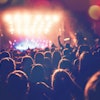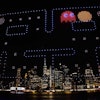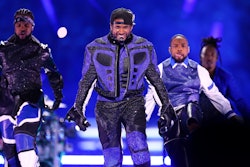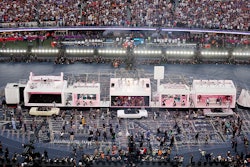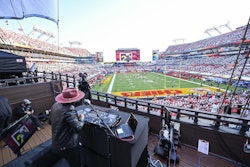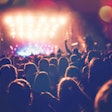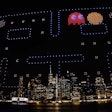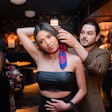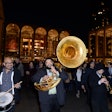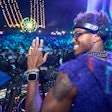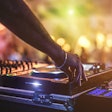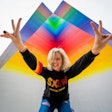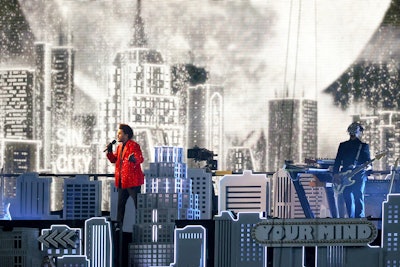
The Tampa Bay Buccaneers defeated the Kansas City Chiefs (31-9) to win Super Bowl LV this past Sunday at Raymond James Stadium in Tampa Bay, Fla. Apart from watching Tom Brady and Patrick Mahomes go head to head for the Lombardi Trophy, viewers also got to watch the Pepsi Super Bowl Halftime Show, headlined by Grammy award-winning artist The Weeknd.
The announcement from Roc Nation, Pepsi and the NFL that The Weeknd was going to be this year's halftime show performer was a surprise for many following last year's show, headlined by Shakira and Jennifer Lopez. The Toronto-born singer, whose real name is Abel Tesfaye, is known for his genre-bending style of music and performances, where he often weaves in greater meaning through costumes or set design. Prior to this year's event, rumors circulated that the self-proclaimed "Starboy" was going to have guest appearances from other A-list artists like Drake, Ariana Grande or Doja Cat—but The Weeknd performed solo, only accompanied by his bevy of masked backup dancers. (The singer also reportedly spent $7 million of his own dollars to ensure the quality of the performance would be up to his standards, after the money the NFL provided him for production costs fell short of what he needed.)
Overall, the nine event producers BizBash spoke with were fairly impressed with the performance and intricate set design, which were pulled off with a limited staff in the thick of a pandemic. Here's what they had to say.
Amir Sahba
Letter Grade: A
"This year's halftime show was created despite the challenges of COVID and with a crew of approximately 1,500—less than half of the size of previous years. Those two facts alone should garner industry praise and high marks for the production team. To create a world-class show and storyline utilizing sets, lighting and perhaps most challenging, a large performance crew (dancers, musicians, etc), while still keeping everyone safe, is a challenge that any production manager had to learn and adopt since the pandemic began.
In this year’s show, all of those key notes were hit perfectly and the team took advantage of the age-old saying, 'location, location, location.' A three-phase space was built beginning with the top of the stadium stands, to what looked like a tunnel and then finally, ended on the field. This created a narrative that distracted viewers from all of the restrictions (including no large dancing audiences around the performers). The smart concept design was well-planned far beyond the set design. Incorporating things like the face masks to the persona of the dancers fit perfectly with The Weeknd’s latest album’s creative direction. And the fireworks and the camera angles allowed the sky to be utilized as the largest display 'screen' of all time.
Overall, it was a well-rehearsed and designed show that encompassed the most important factors of a production. It's important that all parts of an experience are connected with one another, and everyone on the team understands the vision and how to drive it. That happens when the audience feels immersed in the show and every part is perfectly synced in both style and storytelling."
Amir Sahba is the CEO at Thinkingbox, a global creative collective with offices in Los Angeles, Salt Lake City, Toronto, Vancouver and New York. Current clients include Riot Games, Adobe, Intuit, Verizon, Ford and Pinterest.
Trish Rexroth
Letter Grade: B-
"Overall, the halftime show of 2021 entertained me, but I wasn’t wowed. In analyzing a show, I always look for the story and whether the production adds value to those watching at home. Yes, there were a lot of great effects, but this year was a moment where engaging and interacting with the audience at home was critical. Are the senses triggered? Is the imagination heightened? Does the connection with the performance grow throughout?
The initial shot with The Weeknd in the car was as breathtaking and beautiful as any halftime show in recent history. At first, the visual looked like an editorial image or promotional poster that then became dimensional and came to life. From a staging perspective, the cityscape on the top level of the stadium was no doubt ambitious, as this is the first time anything like that has even been possible. I appreciated the design’s imitation of reality: people isolated within a crowded city, close together but also at a measured (and safe) distance. It felt like a community and very lonely, simultaneously. This was likely designed to keep performers at a safe distance from one another; a challenge that was addressed fairly well. The costume design also felt authentic to The Weeknd and his historic artistic choices, while also allowing for performers to wear masks.
Inviting viewers 'inside' the set was a nice change at first, from the cool blue lighting of the outside design to the interior amber gold. After the first few moments, though, the spinning camera became too much and dizzying to follow. Both the outside cityscape scenes and inside set didn’t reach their full potential for me—likely due to the limited ability to capture various camera angles.
As a former dancer, I was really excited when the ensemble choreography (finally) picked up. I felt power and momentum during this portion of the performance, from the dancers marching out together, to the enormity of the red jacket presence on the field, to the freedom when they broke from their initial formation. Also, The Weeknd used the entire field, something that I imagine is also a first given the stage placement and which added scale to the performance. The subtle projection lighting added just enough movement and distortion to make the on-field performance feel similarly futuristic to the upper-level set. When it came to sound, the audio mix was low, but the quality of the vocals was great. The Weeknd’s vocals sounded good through a production lens, and from a vocalist-specific perspective, he was on key, on beat, and not out of breath.
Overall, I liked the more theatrical version of a halftime show rather than a sport-lit music performance—but while we may be talking about certain production elements for years to come, for audiences at home, the performance may not be as memorable."
Trish Rexroth is the executive creative director of full-service experiential marketing agency On Board Experiential (OBE). With offices in San Francisco, Los Angeles and New York, OBE’s clients include JP Morgan Chase, Facebook, Nike and Mulesoft.
Marisa Kurtz
Letter Grade: B ("Production was a B+, but the performance was a B-.")
"COVID sure made everything different this year, including the halftime performance at the Super Bowl. Instead of an army of production folks storming the field to set up and strike a set, the use of a section of the stands to create a unique and clever design that could be built with time was the right and safe choice. I thought the cityscape with the tunnels behind it was unique and looked great on camera.
There were also clever ways to make sure the musicians, dancers and choir were at least six feet apart during the performance, which I appreciated. What I thought was the most interesting was that this performance was produced for the at-home, television-viewing audience vs. the 60,000+ people usually in attendance. Tighter camera shots, a lack of big choreographed numbers, and a focus on details in the set and costumes were a break with the usual 'wow' moments we see at the Super Bowl. While the beginning of the performance was more intimate, the second half was reminiscent of traditional halftime shows, with The Weeknd storming the field and pyrotechnics amplifying the experience.
The choice of The Weeknd as the halftime performance fell flat—not because I’m not a fan of his music, but because the subject matter and his performance style isn’t the typical type of energy we see at the biggest concert of the year. While his vocals sounded great, he didn’t quite command the attention of performers in years past, and some surprise and delight moments would have helped. I kept waiting for him to bring out Ariana Grande or Rosalia, which would have been a huge win."
Marisa Kurtz is a partner at Twenty Twenty Agency, a marketing agency that focuses on experiential marketing, creative services and more for clients including Disney Channel, Salesforce.org, and Ripley’s Believe It Or Not.
Ari Nisman
Letter Grade: B+ ("For the entertainment industry, an A+. We will be back my friends, and it will be better than ever before!")
"The lights, the cameras, the production, the audio, the Pepsi product placement and the performer himself. While all of that is worth discussing, the aforementioned items aren’t last night’s takeaways.
I got dizzy in the mirror scene, and had to look away. I was patiently waiting for a flurry of superstar guests to spice up the night, but they never arrived. The performance was safe, mundane and felt uninspiring despite being completely authentic to who The Weeknd has become. I liked the costumes and the audio was better than normal, but the chorus' eyeballs reminded me of Disney’s Haunted Mansion. Candidly, The Weeknd didn’t approach my previous bars set by Prince, U2 and many others before him.
But who really cares? The Super Bowl’s producers were working with bandages tied around their legs beginning on March 13, 2020. Missing its yearly show elements to work with, like a screaming Super Bowl crowd and the dancing patrons squashed up against the stage, the producers had to delicately social distance its characters so as not be lambasted by reviews, working with a multitude of things foreign to producing the biggest concert on Earth. Yet they tastefully added elements such as white bandage masks to remind us that this performance was quintessentially COVID. But all of that is wildly insignificant to what last night stood for.
Stop for a second. Remember what we saw and think about what it represented. We finally saw a live concert again! The first large-scale, safe live concert attended by a big(ish) audience in a very, very long time. Can you imagine how hard that was to execute? Weeks, if not longer, of live rehearsals in a COVID-friendly way. Last night was a subtle, yet fleeting, return to employment for those behind (and in front) of the curtain in our industry who have been yearning for a chance to roll out cables, position lights, design costumes, prepare catering, design laminates, push buttons and so much more.
What I took away from Super Bowl LV’s halftime performance was a bright light, or even a 'Blinding Light,' if you will. The entertainment industry won’t return with the casual flick of a light switch. It’s going to be a slow, methodic and deliberate turn of a dimmer switch over an extended period of time. [Sunday] night, however, was a cathartic release of my emotions as I saw the first move of that dimmer in the right direction. It significantly emblemized a return for our desperate and beaten entertainment industry. It was the celebration of a return to normalcy, even if it was just 14 minutes and 4 seconds where some of us could dream again, believe again, hope again and know that we’ll be back to the jobs we love and remember so dearly. I finally slept a little better last night thinking about my team, my entertainment family and all of those suffering in our industry."
Ari Nisman is the president & CEO of Degy Entertainment, which produces 3,000 events a year for a wide variety of clients in the corporate, sports, government and other industries. The team also specializes in virtual livestreams, concerts, conferences and events.
Javier Velarde
Letter Grade: C
"There are two reasons why the Super Bowl halftime is the most demanding 'live' show to produce. First, the production team has only a commercial break to set up. Second, the performer has 14 minutes to connect with the audience—both in-stadium and the millions of viewers around the world. That’s no easy feat!
For this year’s production, the NFL pitched in about $10 million. The Weeknd spent an additional $7 million of his own money to enhance the show with scenic and theatrical elements. But even with that much money invested into his production, the show did not seem to connect with the audience. It lacked that 'human connection,' which is what gets people emotionally invested in a show. The most successful Super Bowl halftime shows have used five sure-fire tactics to create a connection with the fans:
1. A big opening stunt. Go big or go home! To kick off the show, you need to grab people’s attention and not let go. Who can forget Lady Gaga dropping out of the sky to start her performance? For $17 million dollars, more could have been done this year than a sliding-doors reveal.
2. Host city tie in. Top artists always manage to weave in the local flavor to their performance. JLo's show in Miami last year, for example, had a predominant Latin vibe. While The Weeknd’s Vegas-themed set fit the concept of his latest album, it felt out of context. Some adaptations could have been made to give the set a Tampa Bay look and feel.
3. America. The Super Bowl is an American tradition like no other. As an artist, it’s the ultimate opportunity to make new fans. Past performers have found ways to incorporate the mood of the nation into their performance. In 2002, U2 opened their set with a tribute to the Sept. 11 victims. Everyone watching was moved to tears. It was that performance when U2 won the heart of America and gained millions of new fans. This year, there was a missed opportunity to honor the front-line workers, the heroes of the pandemic.
4. Collaborations. The Weeknd is not yet at the level where he can perform solo like Lady Gaga or Prince. He would have benefited from having a guest artist on stage with him. It gives you a broader reach and adds an element of surprise to keep people engaged.
5. Get close to the fans. It wasn’t until the end of the show when The Weeknd came onto the field with nothing but an army of dancers. This was the moment when you really felt you were at the Super Bowl. This was the best part of his show and proof that sometimes a good song and choreography is more powerful than expensive production.
Overall, huge respect for the technical, directing and logistical achievements. Artistically, The Weeknd could have done more to create a human connection. This would have made the show feel less like a music video and more like a live performance.
Javier Velarde is the founder and executive producer of Miami-based Triton Productions, an event design and production agency for global brands including ESPN, HBO, Lacoste and SpaceX.
Vince Thompson
Letter Grade: A
“I think overall the production values were amazing and executed to perfection. What people have to understand, and clearly in our industry they do, is that the producers put together a world-class, multimillion-dollar production, in a matter of minutes in a live format. This typically would be in an arena in a controlled environment, and to execute this to perfection in a live format is pretty amazing.”
Vince Thompson is the founder, chairman and chief executive officer of MELT, an Atlanta-based sports, culinary and entertainment marketing agency focused on brand development, event and experiential marketing, social media and sponsorship strategy.
Matt Stoelt
Letter Grade: A
"From the staging in the seats, a mirrored maze, arena-wide lighting and video integration, dual-LED screen backdrops and a massive field performance, producers elevated the Super Bowl LV halftime show to the next level.
Moving away from the traditional mad dash on the field [format] from years past, the show opened with The Weeknd center stage that was integrated into the seating at the top of the stadium. The staging featured dynamic LED set-pieces mimicking a cityscape that cascaded to the rim with two massive LED screens that were synced for content and served as the backdrop. Two additional LED screens flanked the stage for playback to the audience. Dancers, musicians and orchestra members were staggered throughout and behind the set pieces with an energetic and socially distanced performance.
Following two songs on the linear upper stage, The Weeknd made his way backstage and navigated a gold mirrored maze adorned with ornate propping, dimensional signage and up close, sometimes manic POV camera angles.
Moving from the seats high above down to the field, a literal army of dancers blanketed the gridiron, each carrying LED pucks as the cameras moved through and above them. The Weeknd made his way from the upper stage to the field with breakneck speed for the last two songs backed with massive LED screens around the parameter, pyrotechnics and fireworks from above."
Matt Stoelt is the CEO and creative director of Stoelt Productions, LLC, an event, marketing and creative firm with offices in Los Angeles, New York and Miami.
Ty Kuppig
Letter Grade: C
"The Super Bowl halftime show holds a special place in the world of events. As a production, it’s a study of extremes, requiring dynamic design to achieve maximum impact with only minutes to pull physical components together before performance. For the performer and his or her team, it allows a rare opportunity to create a concentrated, high-concept experience—and for us watching, it can be a fantastic, theatrical escape that’s anticipated more than any other televised music event.
After a year tragically defined by the COVID pandemic, we all desperately needed an escape with the Super Bowl halftime show--full of levity, inspiration and hope. Unfortunately, what we witnessed was a dark, poorly conceptualized, two-dimensional production by The Weeknd.
Let me start by saying, I’m a fan of The Weeknd. He’s a talented musician with imagination who clearly understands the importance of creating a visual narrative, as he highlights himself in recent interviews. So then how did we get here? [After his introduction], he performs 'Starboy' and 'Earned It,' and I couldn’t help but feel like I was watching The Weeknd as a special musical guest on a late-night TV show. The set was flat and static, the sound levels were off, and the absence of proper frontal lighting left The Weeknd’s face in shadow as he performed.
From here, we follow The Weeknd as he retreats into a maze of mirrored hallways brightly lit with Vegas-style bulb lights. This is a good moment—I am inspired! I would have loved to see something dynamic like that employed here, but instead, the maze is next flooded with The Weeknd look-alikes with face masks—replacing my excitement with a sense of anxiety and claustrophobia.
The Weeknd returns to the concert-style stage for several more tracks before moving onto the field for the finale. There, he’s met by an army of his bandaged doppelgangers moving in synchronized formation before breaking out into a flash mob-style free-for-all on the turf. As the camera flew over the action, I couldn’t help but think about how uninspired it all felt—no central stage, a total absence of video panels or projection, minimal lighting—no visual anchors to pique our interest. In almost every halftime show, there is a dramatic apex moment as cameras pan over the field showing the full grand display. But here all we saw was a dim arena filled with The Weeknd and his matching cohorts.
So while there were glimmers of interest speckled into the halftime show, they were quickly diminished by the overarching lack of creativity and shortage of excitement, and by the dark and foreboding tone which felt like a complete misstep considering the times."
Ty Kuppig is founder and creative director of TYGER Event Design + Production, a Boston- and New York-based experiential design and event production company working with corporate, brand, nonprofit and private clients including Rolex, American Express, NASCAR and Ocean Spray.
Rick Whetsel
Letter Grade: A-
"I really liked it! I thought that the decision to take advantage of the unique opportunity of having mostly empty stands allowed them to have a very expansive and exciting production design. The way they managed to integrate stage, set and field performances really kept my attention. The Weeknd did a great job of seizing the moment, and managed to come off as a very polished live entertainer. Great work by all involved!"
Rick Whetsel is the vice president of G7 Entertainment Marketing, a full-service agency specializing in entertainment-based marketing, talent booking and production with offices in Nashville and Chicago.

